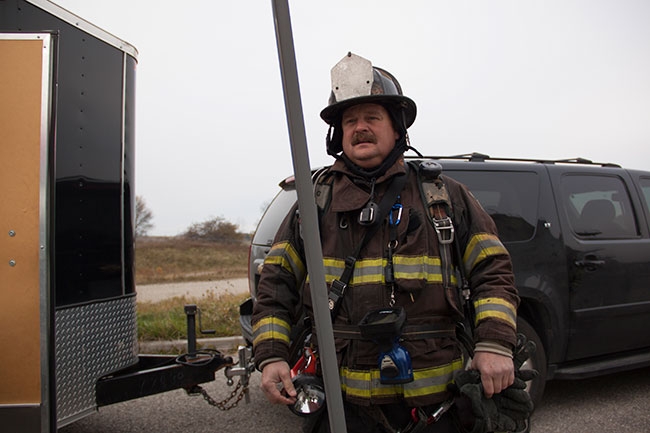
Back to Basics: April 2018
By Mark van der Feyst
Features Fire Ground Training Mark van der FeystIn the January issue of Canadian Firefighter, and part 3 of this series, we looked at taking the necessary action step of orientation. Now, we are going to look at the second action step, which is communication. Communication allows the incident commander (IC) to address the rescue situation as well provide the rapid intervention team (RIT) with the information they need to successfully rescue the firefighter.
 The firefighter is using a radio strap so that the radio is sitting down by his waist area just under the jacket In the January issue of Canadian Firefighter
The firefighter is using a radio strap so that the radio is sitting down by his waist area just under the jacket In the January issue of Canadian FirefighterWithout communication, the chances of a firefighter surviving any ordeal decrease dramatically.
In our current day, we can communicate in many different ways. Some people communicate more with electronic devices than with their own mouth and ears, but on the fire ground, firefighters must verbally communicate with portable radios or with visual cues.
Communication involves at least two people – sender and receiver. Whenever a message is sent out, the receiver needs to be able to receive it, understand it and then respond back to the sender. The firefighter who is calling a mayday needs to be able to send out a message for help, have that message received by IC, and the IC must respond back.
As communication involves at least two people, the question now is, are there any barriers to communication? These two people are not just limited to the mayday firefighter and the IC; it can also include other team members. If the team members are in close proximity, they should be able to and rely upon verbal or visual communication to do so. If the team members can communicate with each other, they are in a better position to assist each other to get out of the situation safely. The team members can also relay information to IC, which can help account for the team members or provide information about their status and safety.
Hopefully, at least one of the team members will have a portable radio, but ideally every firefighter should be carrying one while operating on the fire ground. The portable radio is an excellent lifeline for communications. It allows us to operate further away from IC so that we can accomplish our assignments. Many departments are able to supply radios to their members, however there are some departments that cannot, due to limited budgets and size of membership. Having a portable radio is vital to the rescue and survival of endangered firefighters.
Many firefighters can find their portable radio in the supplied radio pocket of their structural fire fighting jacket. This radio pocket is sometimes specified by the department as to where it will be located and what size it should be. But the radio pocket is not the best spot to keep the portable radio. It is not as protected from thermal heat as it would be if worn on a radio strap under the jacket. When exposed to a heat source of any type, the cord will melt, rendering the microphone inoperable. The radio pocket is constructed from the same material as the outer shell – there is no inside liner protecting the radio from heat. On another note, the cord can also become an entanglement hazard.
In photo 1, the radio microphone is exposed just outside the top of the coat. The rest of the radio is worn underneath the jacket. The firefighter is using a radio strap so that the radio is sitting down by his waist area just under the jacket. The radio and microphone cord running up the front of the firefighter under his coat are protected from the heat. The top end of the mic is the only exposed part of the radio – it is also easier for the firefighter to reach and operate the radio when trying to communicate, while eliminating another entanglement hazard.
If a firefighter doesn’t have a radio, they will need to rely upon direct verbal and visual communication as mentioned in the beginning. Firefighters can make a distress call with a hand tool, such as breaking a window to get someone’s attention, throwing something out of the window, or shining a light at the window. There are many ways that team members can establish rudimentary communications with basic sounds and sight. It is just a matter of using whatever is at our disposal; whether it is a flashlight, hand tool or portable radio.
Communication is the essential when firefighters are calling for a mayday. Good communication strategies can ensure firefighters get the help they need when in trouble – whether it’s a call to the IC or a fellow crewmember.
Mark van der Feyst has been in the fire service since 1999 and is currently a full-time firefighter with the Woodstock Fire Department in Ontario. Mark is an international instructor teaching in Canada, the United States, FDIC and India. He can be contacted at Mark@FireStarTraining.com
Print this page